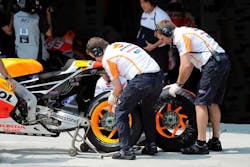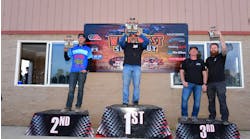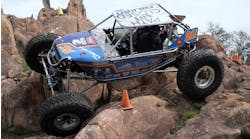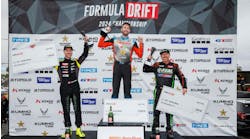Last Sunday’s Malaysian Grand Prix was the penultimate round of the 2015 MotoGP season and was won by Repsol Honda Team’s Dani Pedrosa ahead of the Movistar Yamaha MotoGP duo of Jorge Lorenzo and Valentino Rossi who finished in second and third place respectively.
All three days of the Malaysian Grand Prix were subjected to hot and dry weather, with track temperatures reaching a peak of 50°C during Sunday’s twenty-lap race. The improved performance of Bridgestone’s 2015 specification tires enabled the riders to set a swathe of new records at the Sepang circuit. Pedrosa set a new Circuit Best Lap record of 1'59.053 in qualifying, Lorenzo set a new Circuit Record Lap of 2'00.606 during the race and the overall race time record was beaten by over seven seconds.
Q&A with Masao Azuma – Chief Engineer, Bridgestone Motorcycle Tire Development Department
The Sepang Circuit features a variety of corner types and is always subjected to hot conditions. Which of these factors has the most influence on tire development for this circuit?
“There are a number of factors which combine to make Sepang an especially challenging circuit for tire development. The high temperatures and layout of the circuit with its hard braking zones and fast sections are two of the obvious ones, but potentially even more of a challenge in recent years has been the gradual degradation of the track surface. Not only has the grip level of the asphalt diminished significantly year-on-year, but the undulations in the braking zone have also increased in severity. This means that we’ve had to develop tires that can provide good durability and resistance to overheating for this circuit, with the added element of ensuring the riders have enough grip to make up for the poor track surface, while ensuring the bumps in the corners can be managed effectively. Looking at how our tires performed last weekend, I feel we were able to deliver good tire options for the riders, but there is no doubt that the Sepang Circuit would benefit greatly from being resurfaced in the near future.”
The combination of the medium compound front and rear slicks was used by the vast majority of riders for the Malaysian Grand Prix. What benefits did this tire combination offer to riders that made it so popular?
“The medium compound front and rear slicks proved to be so popular as they were best suited to deal with two of the main issues with the Sepang circuit; a low grip surface and severe bumps in the braking zones. On such a hard-braking circuit with high track temperatures such as Sepang, you’d expect that our hard compound front slick would be the preferred option. However, the severe bumps in many corners meant that the riders felt that the medium compound front slick provided better bump absorption, which gave them better bike control in these tricky sections. For the rear tire, the reason why the majority of riders preferred the medium compound option was that it offered a really good balance of outright grip and consistency and with two long straights ensuring you have good drive out of corners is important. We saw on Sunday that some riders, like Stefan Bradl for example, also could achieve good results using the soft compound rear slick and this is because the excellent grip of this option helped to counteract the poor grip level of the Sepang asphalt.”
The pace at the Malaysian Grand Prix this year was record-breaking, but was still slightly slower than that achieved during pre-season testing at Sepang. Why is there such a discrepancy in lap times between testing in February and the race in October?
“Normally, the riders set their best lap time during the winter tests at Sepang between morning to noon on the final day of the test. At this time, the track temperature isn’t so high and the teams have had enough time to find a good bike setting. However, our data indicates that there the grip level of the circuit during pre-season testing in February is slightly different to that during the race in October and we take this into account when selecting our tire allocation for the Malaysian Grand Prix. What is evident is that this year, the lap-time deficit between testing and the race was less than in previous years. For example, Dani’s qualifying time was only around forty-thousandths of a second off his best time in the first Sepang test and I think the improved performance our tire allocation at this year’s Malaysian Grand Prix was a factor in this result.”
Latest in Racing
Latest in Racing
Racing
Nexen Tire Announces 2024 Motorsports Program
April 19, 2024
Racing
GT Radial Secures Formula Drift Podium Finishes
April 15, 2024




